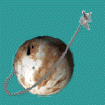|
"Today, rock 84001 speaks to us across all those billions
of years and millions of miles. It speaks of the possibility of
life." -- President Bill Clinton.
NASA and Stanford University scientists announced Wednesday, August 8, they had compelling, but not conclusive, evidence that primitive microscopic life may have
existed several billion years ago on the planet Mars.
![[image of microfossil]](microfossil.jpg) At a press conference in Washington Wednesday afternoon, a team of
scientists led by Dr. David McKay of NASA's Johnson Space Center presented
several key pieces of evidence which, put together, "strongly suggests"
that life once existed on the Red Planet. At a press conference in Washington Wednesday afternoon, a team of
scientists led by Dr. David McKay of NASA's Johnson Space Center presented
several key pieces of evidence which, put together, "strongly suggests"
that life once existed on the Red Planet.
"There is not any one finding that leads us to believe that this is
evidence of past life on Mars. Rather, it is a combination of many things
that we have found," McKay said.
The Evidence
The team presented four lines of evidence obtained from the
analysis of a meteorite ejected from Mars billions of years ago and landed
on the Antarctic continent over 10,000 years ago.
![[image of meteorite]](alh84001.jpg) The first was the confirmation that the meteorite came from Mars,
based on compositional analysis of the rock, and the discovery of globules
of calcium carbonate. These globules formed in cracks in the rock as the
carbonates settled out of solution on the early Mars. The first was the confirmation that the meteorite came from Mars,
based on compositional analysis of the rock, and the discovery of globules
of calcium carbonate. These globules formed in cracks in the rock as the
carbonates settled out of solution on the early Mars.
The second line of evidence was the correlation of these globules
with biological activity. Such globules are formed on Earth by
microorganisms, and the size of the globules (250 millionths of a meter, or
five times the thickness of a human hair) is consistent with terrestrial
globules created by living creatures.
A third line of evidence came from the microscopic examination of
the globules. Scientists noticed the globules have alternating
white-and-black rims ("Oreo cookie rims," as one scientist called them)
composed of the minerals magnetite, phyrrhotite and greigite.
Using a transmission electron microscope (TEM), scientist Kathie
Thomas-Keprta was able to study the distinctive shapes and chemical
composition of crystals of these minerals as well as the environment in
which they formed. The characteristics of the crystals closely match those
found on Earth created by microorganisms.
"They may be created by complicated inorganic explanations, but the
simplest explanation is an organic origin," Thomas-Keprta said.
![[image of eggshaped globule]](eggshaped.jpg) The final, and most controversial, line of evidence was scanning
electron microscope images of the surfaces of the globules. The surfaces
showed a large number of elongated forms which can be explained by
microfossils formed by bacteria or other microorganisms. The final, and most controversial, line of evidence was scanning
electron microscope images of the surfaces of the globules. The surfaces
showed a large number of elongated forms which can be explained by
microfossils formed by bacteria or other microorganisms.
The surfaces can also be explained by weathering and other
inorganic processes, but McKay said they favor an organic origin for the
structures seen.
"Skeptical Optimism"
Not everyone was optimistic or enthusiastic as the NASA scientists.
Dr. William Schopf of UCLA, a scientist not part of the discovery,
expressed a "note of caution" about the findings.
Quoting famed astronomer Carl Sagan, Schopf said, "Extraordinary
claims require extraordinary evidence." He applied seven critical tests of
his own on the data, based on the both the meteorite and the organic
samples found within.
While acknowledging that the age and origin of the rock, as well
as the existence of indigenous organic material, was well known, he was
less supportive of the claims of microfossils and biologic origins for the
organic materials.
He noted that the fractures in the meteorite, in which the globules
of organic materials were found, may have been formed when the meteorite
was ejected from mars by an asteroid impact. If that was the case, and if
the meteorite was subject to high temperatures during that time, it is
unlikely that any organic material found in the meteorite could have been
created biologically on Mars.
![[image of globule]](globule.jpg) He was also less than convinced that the organic materials found in
the meteorite came from living creatures, stating that organic materials
have been found on other meteorites with no biological formation claimed. He was also less than convinced that the organic materials found in
the meteorite came from living creatures, stating that organic materials
have been found on other meteorites with no biological formation claimed.
The microfossils claimed by the researchers are also 100 times
smaller than similar microfossils found in terrestrial rocks, according to
Schopf.
Two Viking landers carried experiments designed to look for
microscopic life forms in the Martian soil. After puzzling early results,
scientists concluded no such life forms currently exist on Mars, at least
near the surface.
He concluded that more science was needed to move a biological
explanation for the data "up the probability scale."
Reaction from Goldin, Clinton
Schopf's conclusion was readily agreed by NASA Administrator Dan Goldin.
"This is the most important thing that must be done," he said.
Goldin also appealed for a logical, scientific approach to future
work, rather than making any appeals to emotion. "We will be governed by
scientific thought and principles and not emotion," Goldin said.
President Clinton also expressed his support for further research
on the possibility of ancient Martian life. Speaking shortly before
traveling to California on a campaign trip, he said, "Like all
discoveries, this one will and should continue to be reviewed, examined
and scrutinized. It must be confirmed by other scientists."
"The fact that something of this magnitude is being explored is
another vindication of America's space program and our continuing support
for it, even in these tough financial times," Clinton said. "I am
determined that the American space program will put its full intellectual
power and technological prowess behind the search for further evidence of
life on Mars."
Clinton used the opportunity to announce the creation of a
bi-partisan "space summit" led by Vice President Al Gore, which will meet
later this year. "A significant purpose of this summit will be to
discuss how America should pursue answers to the scientific questions
raised by this finding," Clinton said. [Ed. note: As of early February 1997 the summit had not taken place or even been scheduled.]
Implications
Although the results announced today were not conclusive,
scientists were clearly very optimistic about the implications of the data.
"If it [life] originated in this solar system, and on more than one
planet in the solar system," said NASA official Wesley Huntress, "why
wouldn't it originate in other solar systems?"
Acknowledging the highly unlikely but not impossible hypothesis of
cross-pollenation of primitive lifeforms between the two young worlds,
Stanford chemist Dr. Richard Zare said, "Who is to say we are not all
Martians?"
|


![[image of microfossil]](microfossil.jpg) At a press conference in Washington Wednesday afternoon, a team of
scientists led by Dr. David McKay of NASA's Johnson Space Center presented
several key pieces of evidence which, put together, "strongly suggests"
that life once existed on the Red Planet.
At a press conference in Washington Wednesday afternoon, a team of
scientists led by Dr. David McKay of NASA's Johnson Space Center presented
several key pieces of evidence which, put together, "strongly suggests"
that life once existed on the Red Planet.![[image of meteorite]](alh84001.jpg) The first was the confirmation that the meteorite came from Mars,
based on compositional analysis of the rock, and the discovery of globules
of calcium carbonate. These globules formed in cracks in the rock as the
carbonates settled out of solution on the early Mars.
The first was the confirmation that the meteorite came from Mars,
based on compositional analysis of the rock, and the discovery of globules
of calcium carbonate. These globules formed in cracks in the rock as the
carbonates settled out of solution on the early Mars.![[image of eggshaped globule]](eggshaped.jpg) The final, and most controversial, line of evidence was scanning
electron microscope images of the surfaces of the globules. The surfaces
showed a large number of elongated forms which can be explained by
microfossils formed by bacteria or other microorganisms.
The final, and most controversial, line of evidence was scanning
electron microscope images of the surfaces of the globules. The surfaces
showed a large number of elongated forms which can be explained by
microfossils formed by bacteria or other microorganisms.![[image of globule]](globule.jpg) He was also less than convinced that the organic materials found in
the meteorite came from living creatures, stating that organic materials
have been found on other meteorites with no biological formation claimed.
He was also less than convinced that the organic materials found in
the meteorite came from living creatures, stating that organic materials
have been found on other meteorites with no biological formation claimed.